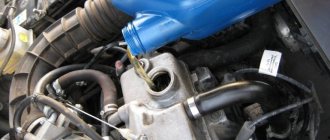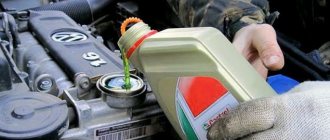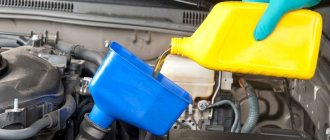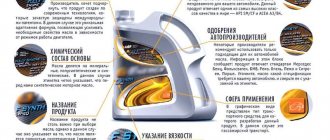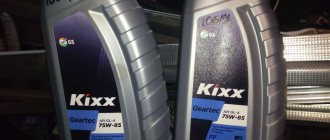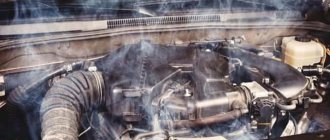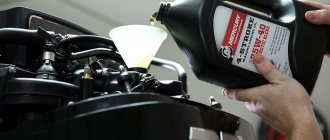Hello! Even those who do not understand the structure of a car at all know that there must be motor oil there. Initially, the function of engine oil was to remove wear products and heat from the friction zone, discharging it into the crankcase, and also to lubricate the crankshaft journals. Then, the oil was assigned the function of lubricating the cylinders and parts of the gas distribution mechanism. Today, on modern engines, motor oil is used as a hydraulic fluid for all mechanisms. And more and more work is being assigned to her.
Why does an engine need motor oil?
So, after all, why does an engine need motor oil? Everything is very simple. It protects the engine by creating a protective film on the parts. This helps reduce friction and wear. In addition, the film protects parts from dirt, corrosion and other harmful impurities. In general, the main functions of motor oil are:
1. Engine protection.
2. Protecting its parts from wear.
3. Corrosion prevention.
4. Overheat protection.
5. Removing engine wear products from important areas, for example, metal shavings remaining after friction.
6. Removing soot, carbon deposits and other fuel combustion products.
In addition to the base itself, that is, the petroleum component of the oil, there are also various additives. They can perform a variety of functions, for example, adjusting oil viscosity, or cleaning engine parts from contaminants. Additives can make motor oil unique because they can enhance or, conversely, weaken various properties.
Engine oil
Motor oil is a vital part of the engine. Pay attention to the schedule for replacing the liquid lubricant; if necessary, add or change this lubricant to a new composition. By choosing the right lubricant for the moving parts of a car engine and ensuring the correct oil level in the engine, you can not only extend its life, but also save on fuel costs.
The most common belief is that car oil is intended only for lubrication, but in addition to this important function, this liquid cools the engine and removes wear products from the point of contact of rubbing pairs.
Engine warming up and oil viscosity
What happens in the engine when it is cold and the oil viscosity is several times higher than the calculated operating one? We recall the school physics course and draw the conclusion: if the oil film is thicker than the gap, the friction force increases, which leads to a drop in power and an increase in temperature. This is precisely the “secret” of engine builders: they calculate the gaps specifically for the operating temperatures of the engine (which for most engines is considered to be in the range of 100-150 °C), deliberately forcing the engine to work under increased loads when warming up.
It is the increased viscosity of cold oil that helps the engine warm up faster. And that is why automakers categorically do not recommend loading the engine until it is completely warmed up. Well, it is for this reason that experts say that one (each) warming up of the engine in severe frosts takes about 300-500 kilometers from the total service life of the new engine (not to be confused with the service life of engine oil - this does not affect the service interval so much).
It should be noted that over time, the internal surfaces of the engine gradually wear out, the gaps increase, and accordingly, the degree of influence of the increased viscosity of cold motor oil on wear decreases.
What is motor oil?
The main function of engine fluid is to lubricate moving components and protect against corrosion. In addition, due to circulation and a sufficiently large volume, automobile oil performs the function of heat transfer with subsequent cooling of engine parts. Corrosion inhibitors and additives that control viscosity stability provide reliable protection for the heart of the car.
To perform its main function, internal combustion engine oil is produced on three main bases:
- Mineral
- Semi-synthetic
- Synthetic
In fact, engine oil is divided into 6 groups based on the type of base composition. Only representatives of the first group, using a product of direct petroleum distillation with subsequent purification, can reliably be called mineral.
Automotive motor oils of the second group, obtained through the hydrocracking process of oil, can be classified as semi-synthetics. the rest of the lubricants can be confidently classified as a synthetic group. The sixth group of oils is obtained from gas processing.
Therefore, answering the question “What is motor oil?” we can confidently answer that it is a complex lubricating fluid obtained as a result of petrochemical processes.
What oil viscosity should I choose: 5W-50 or 0W-30?
Let's reformulate the question: what is worse for the engine, high or low viscosity? Despite the fact that both the manufacturer and many auto mechanics professionally give the same recommendations (the network is literally replete with them!), questions that are often asked on forums and in the comments of various auto portals indicate that even more material needs to be written on the topic of viscosity oils So, what is better to choose, a higher or lower viscosity of motor oil? And what if the warranty service fills in car oil with a viscosity not specified in the operating instructions?
It is important to remember that the viscosity of the car oil must meet the requirements of the car manufacturer, regardless of age, mileage, driving style, budget and the “authoritative” opinion of the professional Uncle Petit, even if he is the very personification of the official service.
We created this article not only with the goal of telling from scratch and explaining what it is for those who doubt the opinion of the service center, as well as for those who are simply curious why this is so. If you are one of these, read on; if not, read the operating instructions (or service book), and demand that you only fill with the engine oil specified by the engine designers (in all respects, including viscosity).
So, let's delve into the issue of engine oil viscosity. The most understandable friction pair in an engine for most car enthusiasts is the “piston-cylinder”, so for clarity, we take this particular friction pair for our in-depth thought experiment.
Oil Standards
The main properties of motor oils are described in the applicable standards. Motor oil standards use viscosity as the main parameter determining lubricating properties. To standardize understanding and for the convenience of the end consumer, they are mainly labeled according to the SAE system. The coding according to this standard indicates the minimum and maximum preferred outside air temperatures when starting the engine.
Seasonal motor oils are rarely used by car owners during normal vehicle operation, with the exception of work in arctic cold or desert heat. Basically, for year-round use and to reduce the cost of technical operation of a vehicle, all-season (universal) lubricants are used, coded XwXX according to the SAE standard.
The first index indicates the properties of motor oils in relation to the optimal temperature for starting in winter conditions. The first index varies from 0w to 20w. The second index indicates the temperature characteristics of engine starting in summer and varies from 30 to 60. The most universal lubricant can be called the one coded SAE 0W60. Such motor oil for cars exists. Its characteristics require engine operation at temperatures from −40C to +60C.
During normal operation of the SAE0W60 engine, its characteristics far exceed the requirements set according to the climatic characteristics of the region in which the engine is operated. Basically, this viscosity more indicates the possibility of using the lubricant in highly loaded, highly accelerated engines. Mainly used in racing environments.
For normal operation, a viscosity of 10W50 is sufficient, which will cover all temperature charts and allow you to safely travel, without fear for the safety of the engine, in almost all latitudes.
There are industry standards for lubricants according to European ACEA standards, according to the international ISO classification, according to the requirements of the American Petroleum Institute - API, according to Japanese - ILSAC, and, of course, according to GOST of the Russian Federation.
All applied standards are interchangeable and overlap the indicators for the main characteristics. Standards differ in gradation and designation.
The API uses a two-letter code and is based on the year of development of the internal combustion engine. For example, API SM - for engines developed in 2004 and younger
ACEA uses an alphanumeric code and categorizes petrochemical products by engine type, operating mode, and durability of the fluid itself. For example, ACEA A3/B3 - for high-performance gasoline and diesel internal combustion engines, for light commercial vehicles and passenger cars. Operation with extended shift intervals is possible.
ISO divides the lubricant on a base basis. For example, ISO 11158 HH - natural mineral liquids.
ILSAC - two letters and a hyphenated number. Indicates compliance with API classification, and characterizes by viscosity, shear rate, volatility, foaming. The GF-5 standard is now in effect, corresponding to API SM
GOST 2004 completely coincides with the API designation. The designation according to the old GOST indicates the viscosity of the lubricant at startup. The designation 6z16 corresponds to 5w40.
Additives
In fact, the properties of motor oils are ensured by a complex of additives. The base base of any liquid lubricant is only 70-95% of the total volume of the canister; the remaining volume is achieved through various additives.
The use of additives provides not only viscosity and operational stability. Additives help minimize the formation of sludge and carbon deposits, as well as minimize possible damage when such deposits get into the engine channels and rubbing vapors.
Key5 ingredients affecting the quality of the lubricating fluid:
- Viscosity Control Additives
- Detergent additives for flushing the system and removing wear debris
- corrosion inhibitors - protection against corrosion of metal products
- anti-wear components - for example, zinc additives required to provide solid lubrication of rubbing pairs when an oil stain drains
- friction modifiers designed to reduce fuel consumption by reducing the friction coefficient of pairs (for example, graphite, molybdenum)
- anticoagulating additives that prevent the formation of paraffin solid compounds at low temperatures.
- foam inhibitors that dampen foam formation that occurs due to the crankshaft churning fluid in the engine crankcase.
How to check oil quality yourself
You can monitor the performance of the oil yourself “by eye”.
However, a more qualified assessment of the lubricating fluid can only be given in a special laboratory. There is a common misconception - if the oil turns black, it means it’s time to change it. However, this is completely the wrong guideline. Moreover, it works the other way around: high-quality motor oil has detergent and dispersant properties. It cleans the engine of combustion products and dirt, and holds this debris in its own volume in a finely dispersed state, preventing blockages in the oil system. If you have driven 1–2 thousand kilometers and the oil remains clean, this is an alarming signal.
Non-blackened oil is a sign that the lubricant does not perform cleaning functions. Dirt accumulates on engine parts, forms plugs in the oil channels, which ultimately leads to wear and tear of the engine.
In addition, the oil may thicken or, conversely, become too liquid. In the first case, you have to constantly worry whether the car will start on a cold morning and change batteries; in the second, you have to add oil due to increased waste. If the oil loses stability too quickly, the reason lies in low-quality ingredients - base oils and additives. There is only one way out here - to choose a higher quality lubricant from a reliable brand, with confidence in the originality of the product.
The surest way to get a professional opinion on the quality of the oil you use is to contact a specialized laboratory. However, experienced drivers know several life hacks on how to check the performance of the lubricant themselves:
- Inspect the oil dipstick and oil fill cap. The appearance of dark clots in the oil is a signal to urgently replace it.
- Pay attention to the color of the oil. If it does not darken during operation, the additives do not cope with cleaning the engine from dirt.
- Inspect the cap and the inside of the oil filler neck for the presence of foam - this is a sign that antifreeze is getting into the lubricant.
- Pay attention to the consistency of the oil - if thick deposits similar to grease are noticeable, urgent measures must be taken.
Any of these signs is a good reason not only for changing the oil, but also for diagnosing the condition of the internal combustion engine at a professional service station.
A more thorough check of the oil can be done using a drop test. We told and showed how to do this here.
What to put in the engine?
Which oil is preferable to use for a particular car is usually stated in the service book. This instruction specifies the viscosity standard of the lubricant according to the SAE gradation. It does not indicate what type of liquid based on the basic composition is recommended specifically for this car. In addition, operational wishes do not take into account the actual operating mode of the machine and climatic conditions.
High-quality synthetic motor oil is usually not poured into engines that have a rich operating history. By today's standards, an engine is considered old when it exceeds 180,000 km. This increase in the retirement age is due to changes in the materials used both in the design of the internal combustion engine itself and in the sealing elements.
Synthetic motor oil is not recommended for use after the threshold value, as it has high fluidity characteristics and high penetrating ability.
The engine will certainly not be any worse, but it will require constant monitoring of the dipstick readings. Fluid will simply leak out of the engine through worn crankshaft seals. For such engines, semi-synthetic oils are recommended.
For light trucks, which usually exceed the maximum recommended commercial load, and when driving with sharp acceleration and reaching maximum speed of the internal combustion engine, it is recommended to use all-season synthetics and semi-synthetics, designed to operate under conditions of maximum temperature differences, up to the 0w60 standard, which is used in racing cars.
When operating the car exclusively in cold or hot weather, the so-called arctic and summer motor oils are recommended, respectively. These types of lubricants are not designed for universal use and are designed specifically for work in the conditions of the Far North and the Sahara.
On which engine should the level be checked - cold or hot?
On cool! That is, the one that stood for a while after work. The meaning is simple: you need the oil to have time to drain from the upper parts into the oil pan, where its level can be determined using a dipstick. You need to wait at least ten minutes, otherwise the measurement will be biased: a significant part of the oil simply will not have time to return from the lines to the crankcase. In this case, the car should stand as level as possible. You should pull out the oil dipstick, wipe it with a rag, then put it back in and take it out again.
I wonder if every driver today knows about the existence of such a dipstick?
I wonder if every driver today knows about the existence of such a dipstick?
Oil for gasoline internal combustion engines and diesel engines
Motor oils for passenger cars are divided into motor oils for gasoline engines and diesel engines. Modern petrochemical standards imply the possibility of such an application. But for older internal combustion engines, the operating temperature schedules differ and gasoline oil is not applicable for diesel engines.
It will not ensure normal operation of the mating rubbing surfaces. As for the temperature conditions of internal combustion engines currently produced, they approximately coincide, and this allows the operation of technical fluids in both types.
Main mistakes when using motor oils
In order to use the oil for the prescribed period without urgent calls to a car service, it is important to avoid common mistakes:
- Violation of the replacement interval. This leads to wear on engine components.
- Overfilling or underfilling oil. In the first case, the oil will create excessive pressure on the seals and may begin to ooze out; in the second, oil starvation may occur.
- Incomplete oil change. The remaining lubricant contains dirt and an acidic environment, which will reduce the effectiveness of freshly filled oil.
- Incorrect selection of oil. If you add lubricating fluid, ignoring the requirements of automakers, it simply will not perform the prescribed functions. For example, the oil film will not be sufficient to reliably protect the engine.
- Mixing oils. Allowed for emergency topping up, but in the long term it will reduce the effectiveness of engine protection.
- Using an old oil filter. Metal fractions, water and soot accumulate on this part, which will contaminate the fresh oil, and eventually clog the filter to such an extent that the oil will not pass through it, which will lead to complete failure of the internal combustion engine.
Are you choosing oil for your car and don’t want to make a mistake? We suggest using our automatic lubricant selection service. You just need to indicate the category, make, model and type of your vehicle - the smart system will show you the optimal oil option and its change interval.
Modern oil in an old engine
The term “old engine” should not be understood as the date of its actual production, not the mileage, but the date of its development. Older engines used construction materials very different from the composite alloys used today.
When selecting oil for an old engine, take into account that corrosion inhibitors intended for aluminum are absolutely useless for cast iron. Accordingly, this affects the total duration of operation of the internal combustion engine.
Universal motor oils
A separate non-system category is universal motor oils. They combine the requirements for gasoline and diesel engines of both passenger cars and trucks. Can be used as a working fluid in hydraulic systems. It can also be used as a lubricant for transmissions.
Due to its versatility, liquid oil of this type is mainly used in automobile enterprises that have a motley fleet of vehicles at their disposal. Basically, the use of a universal composition is justified from the point of view of reducing delivery and warehousing costs. According to the SAE standard, it is classified as 15w40 and 10w40. According to API classification, the marking has the letter X. For example, API GL-4X.
Basically, such oils are certified according to the requirements of agricultural machinery manufacturers.
Motor oils for gas engines
A separate type of liquid lubricant, developed taking into account the absence of liquid fuel that dilutes the oil and the impossibility of using fuel as a coolant - oil for use in engines running on liquefied gas. Such oils are designated SHC and have different viscosities according to SAE standards.
A feature of this oil is increased adhesion to metals, which is especially important at the points of contact between the piston rings and the cylinder walls. In some cases, such products are classified as industrial lubricants, although they are successfully used on heavy automotive equipment.
Other oils for filling into automobile engines in emergency conditions
In case of emergency and it is not possible to fill the recommended lubricant, short-term use of liquid lubricants used for marine and diesel engines, aviation and even turbine oils is possible.
The use of non-recommended types of oils is possible only in emergency situations when it is impossible to tow the car or the towing service is unavailable. An emergency mileage of no more than 50 km is possible with mandatory flushing of the lubrication channels before changing the oil.
After filling with oils not intended for use in automobile internal combustion engines, it is necessary to replace sealing rubber products, since additives in industrial and industrial oils destroy the structure of the material. As an addition, after operation with different oils, it is recommended to perform a partial overhaul of the engine with defective crankshaft journals.
Didn't find the information you are looking for? on our forum.

